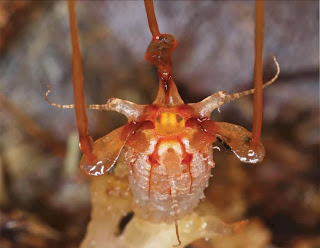A peculiar plant that needs no daylight and sucks on underground parasites for supplements has turned up in Borneo, Malaysia, 151 years after it was first archived.
Thismia neptunis is what's known as a "mycoheterotroph," which means it's a piece of a gathering of plant animal varieties that has surrendered photosynthesis totally, for living as parasites. They develop no useful leaves and do the greater part of the work they have to survive underground. T. neptunis is most effortlessly recognized by its sexual organ: a little, 3.5-inch (9 centimeters) blossom it jabs out of the ground, that seems as though it may have a place on an outsider planet or maybe somewhere down in the sea.
Rather, it develops in the wet earth of a rainforest close by a waterway in a zone called Matang massif.
The Italian botanist Odoardo Beccari first archived the small blooming weirdo in 1866, making lovely illustrations of its surprising shape that helped current scientists distinguish examples they found in a similar locale in 2017.
"As far as anyone is concerned, it is just the second finding of the species altogether," the group of Czech specialists wrote in a paper distributed Feb. 21 in the diary Phytotaxa.
The blossom is sufficiently little to neglect, however bizarre once took note. It has a place with the sort Thismia, a gathering of firmly related plants casually alluded to as "pixie lights." And the Czech group's photos uncover that it looks astoundingly like Beccari's unique illustrations.
Its smooth stem, "whitish or velvety," the analysts composed, jabs up from a straightforward arrangement of roots intended to urge supplements from underground parasites. Its globule has the state of a wounded and swollen thumb — just it is debilitated pale, striped with red, and has an opening at the tip like the mouth of an ocean worm. The most emotional piece of the blossom is the trio of "red, furry" members staying straight up like a shrimp's long radio wires from level distensions around the knob — part of its dust delivering organ.
The analysts said they don't know accurately how the plant pollinates, however they found two types of dead fly inside the bloom, which they said may go about as pollinators.
Mycoheterotrophs like T. neptunis are the gentler of the two sorts of parasitic plants that evade daylight. The growths they drink from do connect to close-by photosynthesizing plants, yet the mycoheterotrophs don't attack those plants specifically. That isolates them from haustorial parasites, which sink hungry roots specifically into the plants they live on, as indicated by a reality sheetfrom botanists at Southern Illinois University[JB1] .
The scientists composed that their rediscovery of T. neptunis is a piece of a more extensive example of researcher finding new and missing types of plants in rainforests in the most recent decades, even as rainforests all around the globe are contracting and undermining breakdown.
It's obscure, they composed, the broadness of T. neptunis' range, or how that range has moved since 1866. Beccari didn't depart definite data on absolutely where he found the blooms, however he was remaining in a lodge close where the specialists spotted it as of late.
The analysts composed that the disclosure makes them more cheerful that they may experience two more plants Beccari portrayed from his chance in Malaysia that haven't been seen since, in light of the fact that the district of rainforest where he worked (and where T. neptunis was found) has remained to a great extent undisturbed.
Odd, Parasitic 'Pixie Lantern' Reappears in the Rainforest After 151 Years
March 07, 2018
air plants terrarium,
cactus house plants,
fairy gardens ideas,
fairy gardens plants,
Green Plants,
house plants online,
indoor plants dubai,
succulent plants for sale,
terrarium plants for sale



